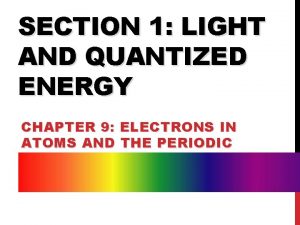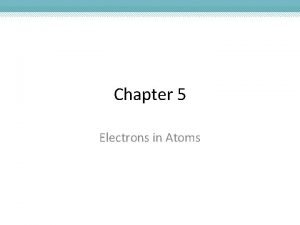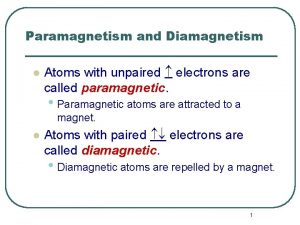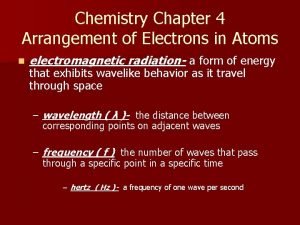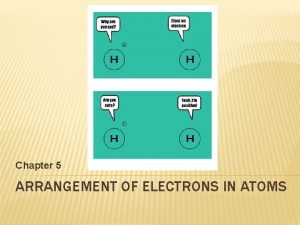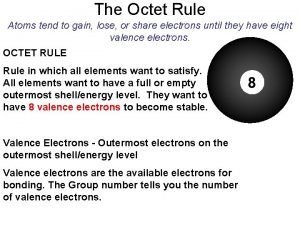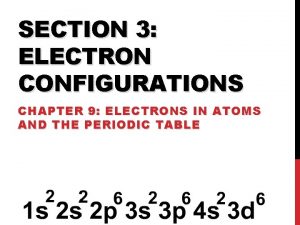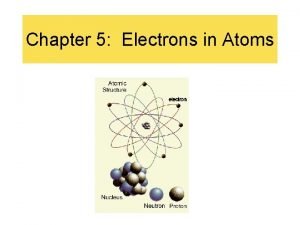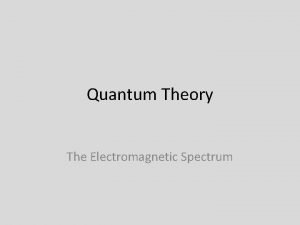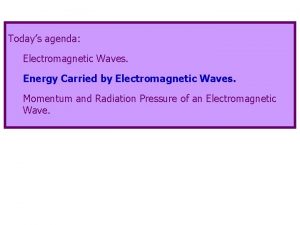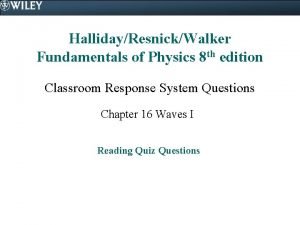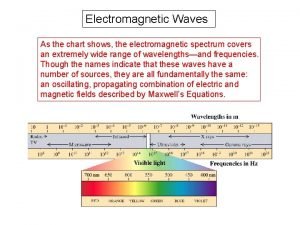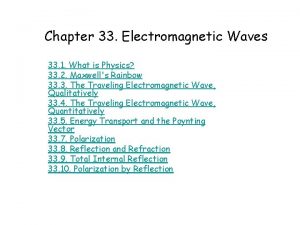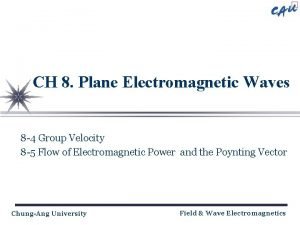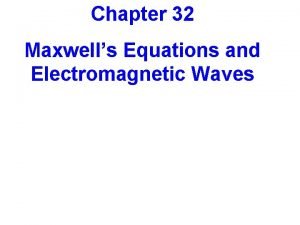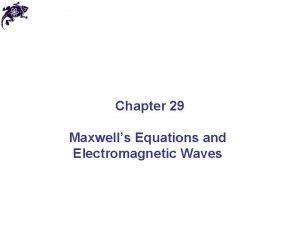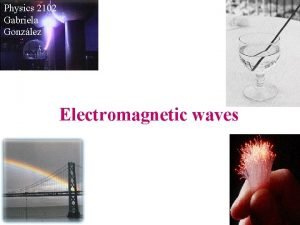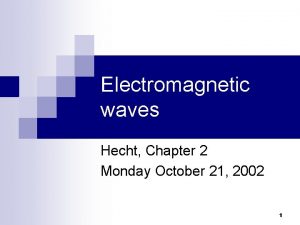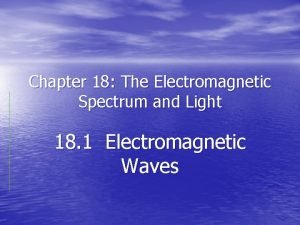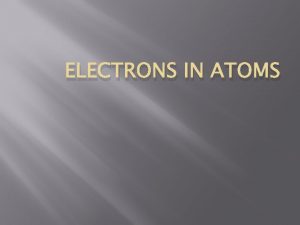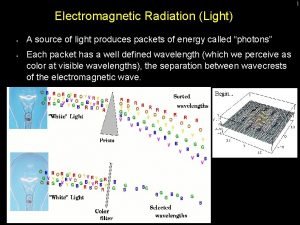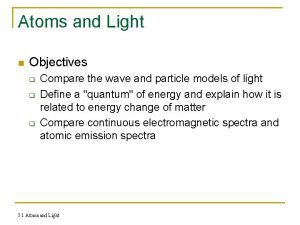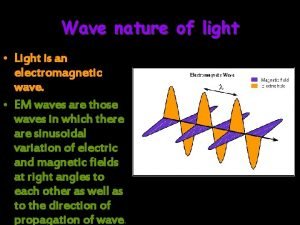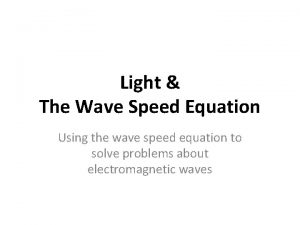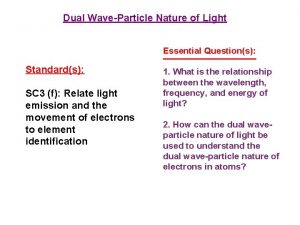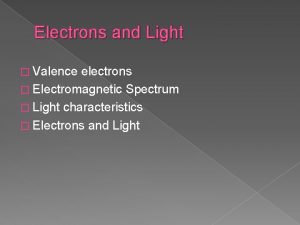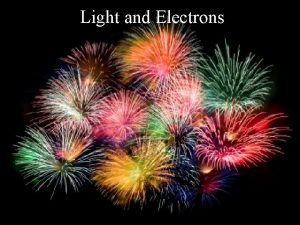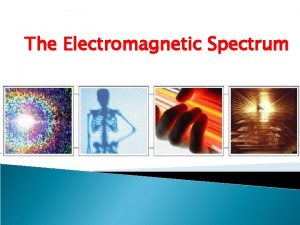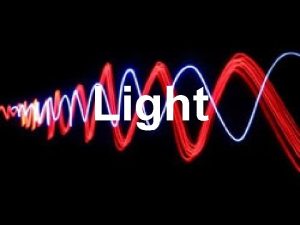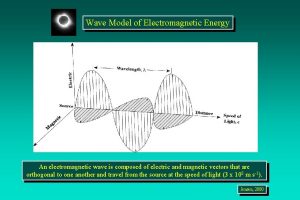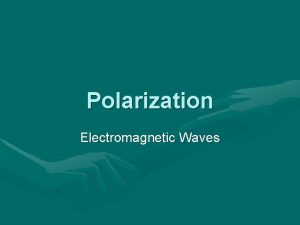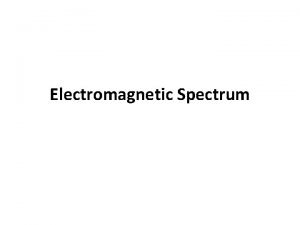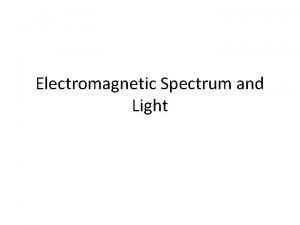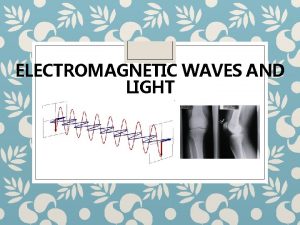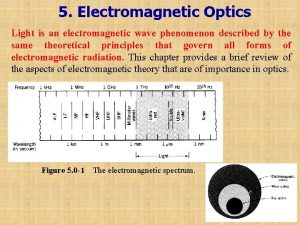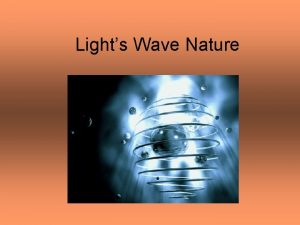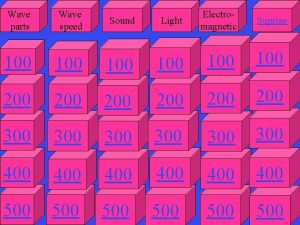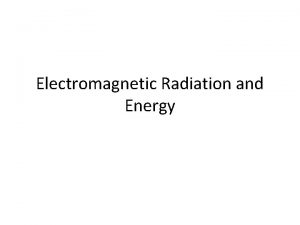ELECTRONS IN ATOMS Wave description of light Electromagnetic






















































- Slides: 54

ELECTRONS IN ATOMS

Wave description of light Electromagnetic spectrum - made of electromagnetic radiation (forms of energy that exhibit wavelike behavior as they travel through space). Electromagnetic waves - combination of electrical and magnetic fields which travel at the speed of light c = 3. 00 x 8 10 m/sec

Wavelength λ (lambda) – usually measured in nm or Ångstroms (Å)

Relative sizes of wavelengths

Frequency ν (Greek letter nu) (or f) – units are usually cycles/sec, sec – 1, or Hertz (Hz). F r e q u e n c y

c = λ ν = 3. 0 x 108 m/sec www. atmos. washington. edu/~hakim/301/handouts. html

The Photoelectric effect The emission of electrons from a metal when light shines on the metal. The number of electrons and their energies depends on the brightness of the incident light. http: //www. astro. virginia. edu/class/oconnell/astr 30/im/photoelectric-effect-2. jpg

Max Planck (1900) E=hν He suggested that the object emits energy in small, specific amounts called quanta. A quantum is the minimum quantity of energy that can be lost or gained by an atom. He proposed E = h ν where E = energy in Joules, ν = frequency , and h = Planck’s constant; 6. 626 x 10 -34 J·s

What is a Joule? A Joule is the derived unit of energy in the SI system. It is the energy exerted by a force of one Newton acting to move an object through a distance of one meter. James Prescott Joule I Joule = Force x distance = 1 Newton-meter = (mass x acceleration) x meter= kg· 2 m/s m= 2 2 kg·m /s

Einstein and wave-particle duality (1905) abyss. uoregon. edu/~js/images/wave_particle. gif

Light – particle and wave? Each particle of light carries a quantum of energy which Einstein called photons. A photon is a particle of electromagnetic radiation having zero mass and carrying a quantum of energy. For an electron to be ejected from the surface of a metal, the metal surface must be hit by a single photon possessing at least the minimum energy required to knock the electron loose (multiples of whole numbers of photons) Each metal has electrons bound to its surface with different strengths so the minimum frequencies differ with each metal.

Spectroscopy

e n i L t h g i r B m o t The Hydrogen-a m u r t c e p S n o i s s i m E


Energy of photons emitted When an excited hydrogen atom falls back from an excited state (a higher potential energy than it has in its ground state) to its ground state (lowest energy state of an atom) or a lower energy state, it emits a photon of radiation. ΔEphoton = E 2 -E 1

Bohr (Niels) Model of the Atom - 1913

Evidence for Electrons in Fixed. Energy Levels The collection of narrow bands of light energy is referred to as an emission line spectrum, and the individual bands of light are called spectral lines. The concept of electron energy levels is supported by spectral lines.

Combining equations Given: E = h ν and ΔE = E 2 -E 1 combining them results in ν = ΔE = ( RH) 1 - 1 h h n 2 i n 2 f Further simplification: ΔE = ( RH) 1 - 1 n 2 i n 2 f

Bohr Model of the atom � � � Electrons in hydrogen atoms exist in only specified energy states. Electrons in hydrogen atoms can absorb only certain specific amounts of energy and no others. When the excited electrons in a hydrogen atom lose energy, they lose only specific amounts of energy as photons. Different photons produce different color lines as seen in a bright line-emission spectrum. The main problem was that this explanation could not explain the behavior of any other element besides hydrogen.

What led to quantum theory? The visible bands in a spectra are called the Balmer series. The UV and IR lines are called Lyman and Paschen series, respectively. Scientists expected to see a continuous spectrum. This observation of the hydrogen atom led to quantum theory.

If electrons behave as both particles and waves, where are they located in an atom?

Heisenberg Uncertainty Principle (1927) It is impossible to determine simultaneously both the position and velocity of an electron or any other particle. (Δp) (Δ x) = h (Planck’s constant) Δp = uncertainty in momentum (p = mv) Δx = uncertainty in position

The Quantum Model of the Atom 1924 Louis de Broglie Electrons should be considered as waves confined to the space around the nucleus. http: //youtube. com/watch? v=x_t. Nzeou. HC 4 Animated Quantum video (double slit experiment) Bohr applet: http: //www. colorado. edu/physics/2000/quantumzone/bohr. html

Derivation of the de Broglie wavelength equation Einstein E = mc 2 Therefore: Planck E=hν mc 2 = h ν [Substitute v (any velocity) for c] mv 2 = h ν [rearrange and substitute v for c in c = λν; then solve for ν = v ] λ mv 2 = hv λ Substitute, rearrange, solve for λ = hv and simplify even further: mv 2 λ=h This is the de Broglie wavelength mv equation

Germer and Davisson De Broglie’s equation was applicable to any object, not just atoms. The wave properties of electrons were demonstrated in 1927 by Germer and Davisson (U. S. ) using diffraction by crystals. This technique is used today in electron microscopy.

Erwin Schrödinger and the wave mechanical model (Ψ + Ψ ) + 8π2 m (E-V) Ψ = 0 x 2 y 2 z 2 h 2 Ψ(psi) = wave amplitude function m = mass of electron E = energy V = potential energy x, y, and z are the coordinates in space where the equation is solved

� � Bozeman Science – Quantum mechanical model (4: 35 min) https: //youtu. be/accy. CUzasa 0

Wave functions = orbitals The solutions to his equation are known as wave functions and they describe the regions in space where there is a high probability of finding the electron at the point in space for which the equation was solved. These regions of space are called orbitals.

Quantum numbers Describe the properties of atomic orbitals and the properties of electrons in these orbitals. There are 4 quantum numbers, the first three of which result from the solutions to Schrödinger’s wave equation. Principal quantum number (n) – the main energy level occupied by the electron. n= 1, 2, 3, 4, . . . The total number of orbitals within a given shell is equal to n 2. The total number of electrons within a given shell is equal to 2 n 2.


Orbital (or azimuthal) quantum number (l) or angular momentum quantum number Values include l = 0, up to and including n-1 The letter designations originally stood for sharp, principal, diffuse and fundamental. These words were used to describe different series of spectral lines emitted by the elements. Orbital quantum number Letter designation Number of orbitals Number of electrons per sublevel 0 s 1 2 1 p 3 6 2 d 5 10 3 f 7 14


Magnetic and spin quantum numbers Magnetic quantum number (ml) – indicates the orientation of an orbital around the nucleus. Values range from –l to +l (defines how many of each type of orbital exists) Spin quantum number (ms) – indicates the two possible spin states of electrons in orbitals. Values are either + ½ or – ½



s o r b it a l

p orbitals

d orbitals

f orbitals

Electron configuration notation � � � Long hand configuration (always start with 1 s) Short hand, or noble gas configuration (use the noble gas immediately preceding the element in question, put its symbol in brackets [ ], and then write out the outer shell configuration. Orbital diagram/notation configuration

Order of orbital filling

Energy in orbital filling

Electron configurations- rules Aufbau principle: An electron occupies the lowest energy orbital that can receive it. Diagonal Rule

Hund’s Rule orbitals of equal energy are each occupied by one electron before any orbital is occupied by a second electron, and all electrons in singly occupied orbitals must have the same spin.

Pauli Exclusion principle no two electrons in the same atom have the same set of four quantum numbers. The first three may be the same, but the spin must be opposite.


Order of orbital filling http: //intro. chem. okstate. edu/Work shop. Folder/Electronconfnew. htm l

Example 1 Boron – atomic number 5 Longhand: 1 s 22 p 1 Shorthand: [He]2 s 22 p 1 Orbital diagram: 1 s 2 s 2 p

Polonium – atomic number 84

Example 2 Orbital diagram: Polonium – atomic number 84 Longhand: 1 s 22 p 63 s 23 p 64 s 23 d 104 p 65 s 24 d 105 p 66 s 24 f 145 d 106 p 4 Shorthand: [Xe] 6 s 24 f 145 d 106 p 4

Exceptions to the Aufbau principle For Chromium (Cr) we would predict: 1 s 2 2 p 6 3 s 2 3 p 6 4 s 2 3 d 4 but it is actually -->1 s 2 2 p 6 3 s 2 3 p 6 4 s 13 d 5 For Copper (Cu) we would predict: 1 s 2 2 p 6 3 s 2 3 p 6 4 s 2 3 d 9 but it is actually --> 1 s 2 2 p 6 3 s 2 3 p 6 4 s 1

Degenerate orbitals a group of orbitals with the same energy Examples: Chromium (24) Cr Shorthand: [Ar]4 s 13 d 5 NOT [Ar]4 s 23 d 4 Mo and W are similar Copper (29) Cu Shorthand: [Ar]4 s 13 d 10 NOT [Ar]4 s 23 d 9 Ag and Au are similar

Additional Definitions Paramagnetic: An atom has unpaired electrons in its electron configuration. (Look at its orbital diagram) Diamagnetic: All electrons in an atom are paired. (Look at its orbital diagram)

Ion Configurations Electrons will be added to, or taken away from orbitals in the following order: s, p, d, f (i. e. the “outer” or “valence” shell first) Examples: Cl- 1 s 22 p 63 s 23 p 5 for Chlorine becomes 1 s 22 p 63 s 23 p 6 Na+ 1 s 22 p 63 s 1 for sodium becomes 1 s 22 p 6
 Electrons in atoms section 1 light and quantized energy
Electrons in atoms section 1 light and quantized energy Electrons in atoms section 1 light and quantized energy
Electrons in atoms section 1 light and quantized energy Mechanical and electromagnetic waves
Mechanical and electromagnetic waves Mechanical and electromagnetic waves similarities
Mechanical and electromagnetic waves similarities Light is electromagnetic wave true or false
Light is electromagnetic wave true or false Chlorine orbital notation
Chlorine orbital notation At stp which substance is the best conductor of electricity
At stp which substance is the best conductor of electricity Atoms with 4 valence electrons
Atoms with 4 valence electrons Atoms with unpaired electrons are called diamagnetic.
Atoms with unpaired electrons are called diamagnetic. Label an atom
Label an atom What is the lowest allowable energy state of an atom
What is the lowest allowable energy state of an atom Electrons in atoms section 2 quantum theory and the atom
Electrons in atoms section 2 quantum theory and the atom Arrangement of electrons in atoms chapter 4 test
Arrangement of electrons in atoms chapter 4 test Stable electron configurations are likely to contain
Stable electron configurations are likely to contain Chapter 5 arrangement of electrons
Chapter 5 arrangement of electrons What is the oxidation number of lithium
What is the oxidation number of lithium How do chemists model the valence electrons of metal atoms?
How do chemists model the valence electrons of metal atoms? 7 ionic and metallic bonding practice problems
7 ionic and metallic bonding practice problems S orbital
S orbital 5 electrons in atoms
5 electrons in atoms Light light light chapter 23
Light light light chapter 23 Into the light chapter 22
Into the light chapter 22 Chapter 22
Chapter 22 Electromagnetic wave spectrum song lyrics
Electromagnetic wave spectrum song lyrics Electromagnetic wavelength formula
Electromagnetic wavelength formula Energy density in em waves
Energy density in em waves Electromagnetic spectrum chart
Electromagnetic spectrum chart Seismic waves are mechanical waves
Seismic waves are mechanical waves Physics classroom
Physics classroom Electro magnetic spectrum chart
Electro magnetic spectrum chart Intensity in em wave
Intensity in em wave Power of electromagnetic waves
Power of electromagnetic waves Electromagnetic
Electromagnetic Maxwell's theory of light
Maxwell's theory of light Intensity of wave
Intensity of wave Poynting vector and intensity
Poynting vector and intensity Chapter 18 the electromagnetic spectrum and light
Chapter 18 the electromagnetic spectrum and light Light electromagnetic
Light electromagnetic Light electromagnetic
Light electromagnetic Electrons and light pogil activity 5-1
Electrons and light pogil activity 5-1 What is a semiconductor used for
What is a semiconductor used for Difference between full wave and half wave rectifier
Difference between full wave and half wave rectifier Difference between transverse wave and longitudinal wave
Difference between transverse wave and longitudinal wave 20 v
20 v Center tapped full wave rectifier formula
Center tapped full wave rectifier formula P and s wave chart
P and s wave chart Full wave rectified sine wave fourier series
Full wave rectified sine wave fourier series What is a wave
What is a wave Wave wave repeating
Wave wave repeating Even quarter-wave symmetry
Even quarter-wave symmetry Wavelength formula triangle
Wavelength formula triangle Match the wave term to its correct description.
Match the wave term to its correct description. The wave nature of light
The wave nature of light Wave speed equation for light
Wave speed equation for light Photon
Photon
